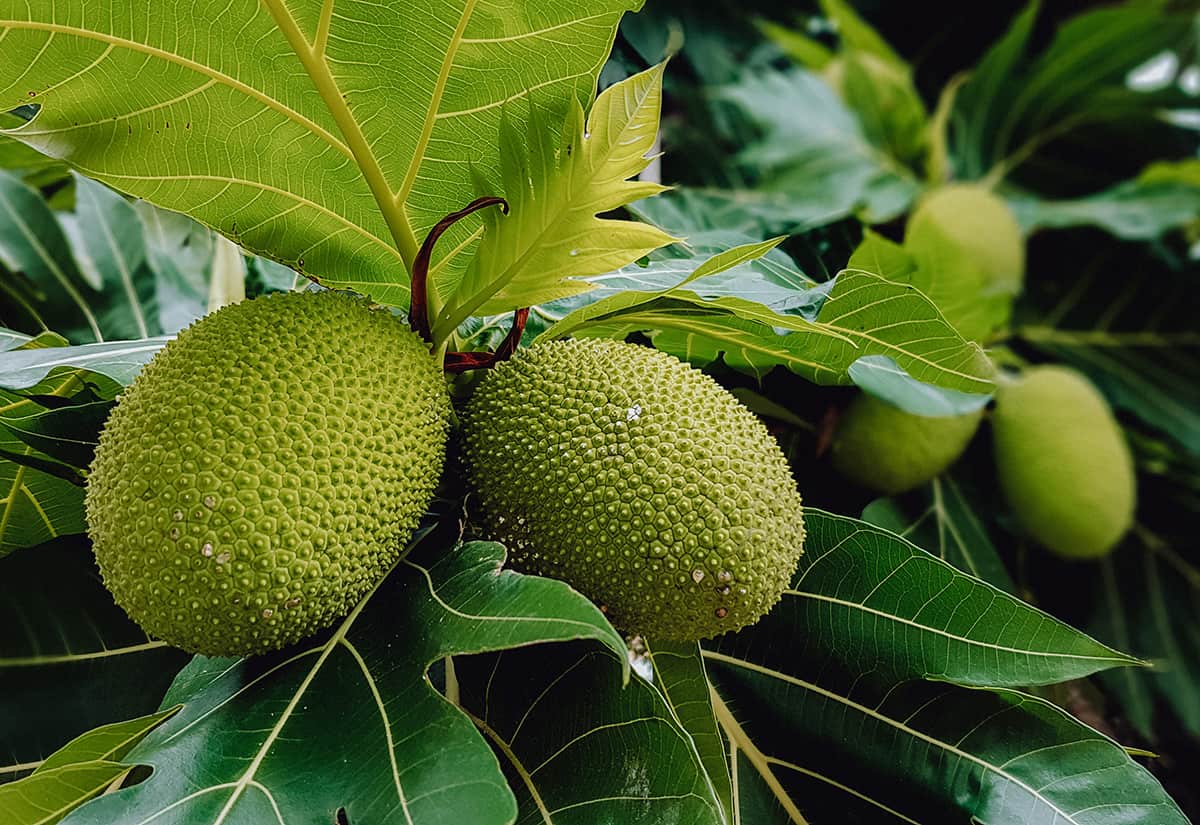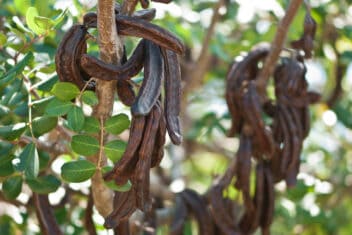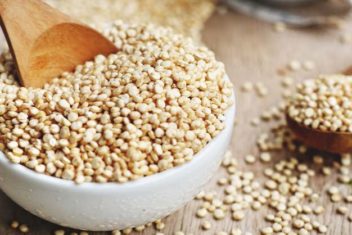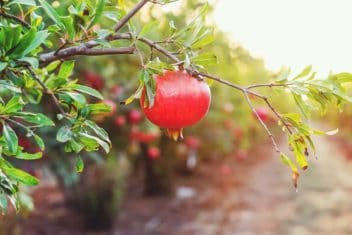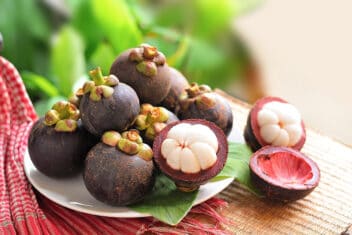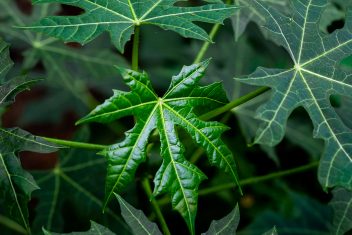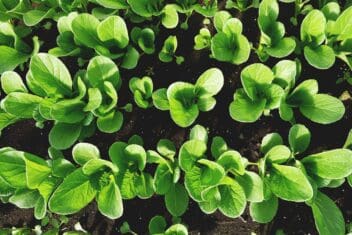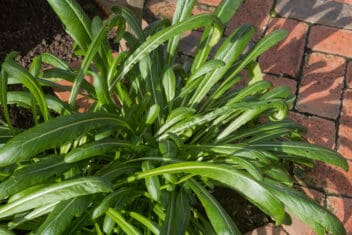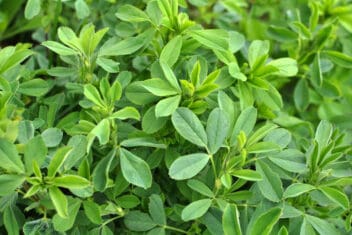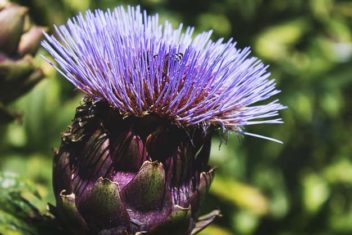I’ve been obsessed with growing breadfruits ever since I read about them in adventure books as a boy. People stranded on tropical islands in the middle of the ocean survived on them, and for that reason, they became something to admire for me.
From the same family as mulberry and jackfruit, breadfruit is similar in texture to freshly cooked bread, and it tastes a little like potato.
Today, breadfruit is grown in over 90 countries. You can grow it too, as long as your climate is right, of course.
Let’s get started on how to grow this historically significant fruit (that just happens to taste yum)!
What is Breadfruit?
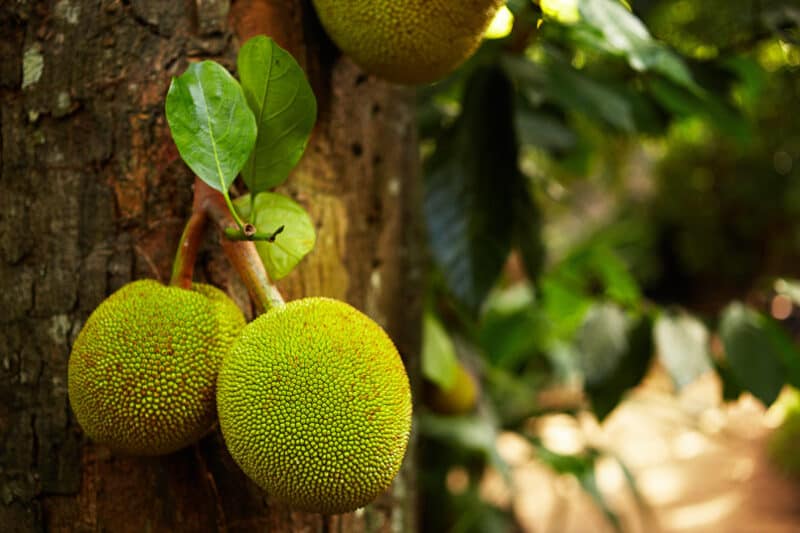
Breadfruit (Artocarpus altilis) can be found growing worldwide, used for food, medicine, boat building, and to prevent erosion of hillsides. All parts of the tree are used, and they are an important part of the ecosystem, wherever they grow.
Originally from New Guinea, breadfruit was spread around the Pacific by Islanders as they explored. Later, Europeans became interested in breadfruit as early as the 1500s and brought the trees to various islands as they traveled.
Varieties of Breadfruit
There are hundreds of breadfruit varieties, and many look completely different from the standard green orb often seen in photos. Some are perfect for home growing, so we’ll cover those varieties.
Aravei
This is a large variety that starts spiky, but the spikes drop off as the fruit ripens. They have a yellow and green rind with a light yellow flesh. ‘Aravei’ cooks quickly and is one of the nicest-tasting of all the breadfruit.
Maohi
This is a common variety that is quite small compared to some other breadfruits. It needs a longer cooking time than ‘Aravei,’ but it’s tender and has an exceptional flavor.
Pucro
This is my choice of breadfruit, and if you’re able to get your hands on it, it’s worth trying out. The skin is yellow and green, with yellow flesh. This is a quick-cooking breadfruit with a subtle flavor that is highly sought after.
Paea
‘Paea’ is a large variety that takes a good while to cook (at least an hour). It’s a bright yellow color, and once cooked, the flesh flakes away for eating.
Havana
A sought after variety, ‘Havana’ has lovely sweet flesh, but they don’t last long. Once picked, they perish within a couple of days. Cook them, and they have a delicious flavor that will make you fall in love with breadfruit.
Other varieties worth checking out include:
- Otea
- Puaa
- Ulu fiti
- Mei
There are literally hundreds of more breadfruit varieties, but the above listed are the most suitable for home gardens.
How to Plant Breadfruit
Breadfruit can be planted in USDA Zones 9b to 11. The average air temperatures need to be between 60-100°F during the growing season. Anything under 40°F will damage or kill your breadfruit tree.
You can plant in containers in cooler areas and move outside in the summer, although they can be heavy because you need a big pot.
Breadfruits need full sun. If you have them planted in pots, rotate them throughout the day to follow the sun if they don’t get enough in one spot.
One of the great things about breadfruit is it can thrive in a variety of soils, but they prefer soil that is fertile, deep, and drains well. Soil with a bit of sand is ideal.
It needs a pH of 6.0 to 7.4.
Breadfruits grow big. They can grow anywhere between 65 and 85 feet tall, so you need to ensure you have space for a tree that tall.
If you don’t want to let it grow that big, prune to about 25 feet high and maintain it at that height. You can also try keeping it smaller, but it will impact the number of fruits you get.
In spring, plant breadfruit when the temperature is consistently over 40°F, but closer to 60°F is better.
Planting Seed
You can purchase or harvest seeds from a fruit.
To harvest your own, remove seeds from a healthy breadfruit. You don’t want to take seeds from one that is diseased or old. Use them straight away because they don’t store well.
Wash away any pulp and plant in a small pot with a good quality seed raising mix. Spray with a water bottle and make sure the soil doesn’t dry out.
It’s as easy as that. You should see germination in as little as 14 days.
Keep the breadfruit tree in pots for about a year, gradually increasing the container’s size as it grows.
Planting a Root Sucker
Breadfruits grow better from a root sucker, not from a cutting of the tree. Often a root sucker will grow from an exposed root or through the soil.
To get one, gently dig around the cutting to expose the root. Then, cut off the shoot, making sure it’s at least nine inches long and has at least a few leaves. Gently nick the bark that’s going to be underground.
Dip the lower end of the cutting into rooting hormone solution.
Plant in good quality seed raising mix, sinking the cutting to the soil several inches. Water well, and don’t allow the soil to dry out.
When the breadfruits are about two feet tall, transplant outside to where you are planting them permanently.
Breadfruit trees grown this way take up to seven years to fruit. That’s why I plant trees bought from a nursery, but it’s fun to create your own plant from seeds and root suckers.
Planting Transplants
When transplanting purchased plants, dig a hole at the same depth as the existing soil in the container and twice as wide.
Gently remove the plant and lower it into the hole. Pack soil in around the rootball.
Place a ring of mulch around the plant, leaving at least six inches between the mulch and the trunk of the tree.
Container Growing
You can grow breadfruit in containers, and they do look nice. The only thing is, you won’t get many fruits, if any, because you have to keep them pruned to shape.
Use good quality potting mix and choose a container that is twice the size of the root ball. Make sure the container and potting mix drain well.
Water once a week until the water drains from the pot at the bottom.
Keep the container in the sun and rotate often to expose all of the tree.
Within about four years you will need to prune to shape and control the size.
Caring for Breadfruit Trees
Breadfruits, as with all plants, have some specific requirements if you want to keep it as healthy as possible.
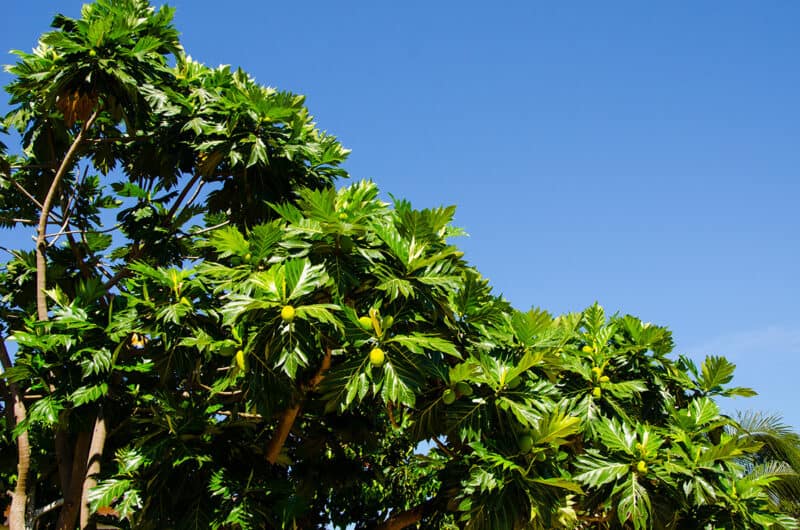
Fertilizer
Breadfruits are hungry in their first year. It pays to feed twice in the first year with a complete fertilizer like an NPK 10-10-10. Then, fertilize once a year in the spring.
Water well when you fertilize and apply mulch directly afterward.
Water
The best time to water is in the morning. Spread it out twice a week if you can. If you notice the leaves wilting, the breadfruit needs more water.
Make sure you water out to the dripline to ensure that the roots get evenly wet.
Pruning
Because breadfruit grows so big, it’s wise to prune regularly to maintain a manageable size.
Prune to maintain the lower branches where you can easily reach fruit. Don’t prune too hard though. You don’t want to cut away more than 1/3 of the tree at any one time.
Companion Planting for Breadfruit
Comfrey planted around the base of breadfruit assists in adding nitrogen to the soil. Additionally, try growing breadfruits with:
Common Problems and Solutions for Growing Breadfruit
Breadfruits are relatively resistant to most diseases, but there are several pests you need to watch out for.
Mealybugs
If you see a cotton-like residue on the breadfruit leaves, you likely have mealybugs.
They suck the sap out of the leaves and soft stem, weakening the plant and inviting other issues.
If there is a sticky residue as well, this is probably honeydew, the sweet excretion of mealybugs, and a number of other pests.
You can wipe the bugs with rubbing alcohol to kill them. Prune away badly infested areas.
Scale
Scale are sap-sucking insects, which leave deposits of honeydew. They’re voracious feeders and can easily kill a young, tender plant.
Our guide can help you identify and get rid of this pest.
Aphids
Aphids are sap-sucking insects that will overwhelm plants through sheer numbers. They also excrete honeydew like scale and mealybugs.
Aphids are controllable through natural means by introducing predators including ladybugs and lacewings.
You could also introduce plants that aphids despise like fennel, mint, dill, and yarrow.
Check out our guide to this common pest if you want to get them under control.
Sooty Mold
All three pests listed above excrete honeydew. If you see your plant covered in a black, ashy coating, the honeydew has likely caused sooty mold.
Spores land on the sticky honeydew and reproduce and before you know it, your breadfruit tree looks like it has been burned all over.
Breadfruit won’t die from sooty mold, but they will suffer from the pests that cause the problem. That’s why the best remedy for sooty mold is to rid the breadfruit of the pests.
Harvesting Breadfruit
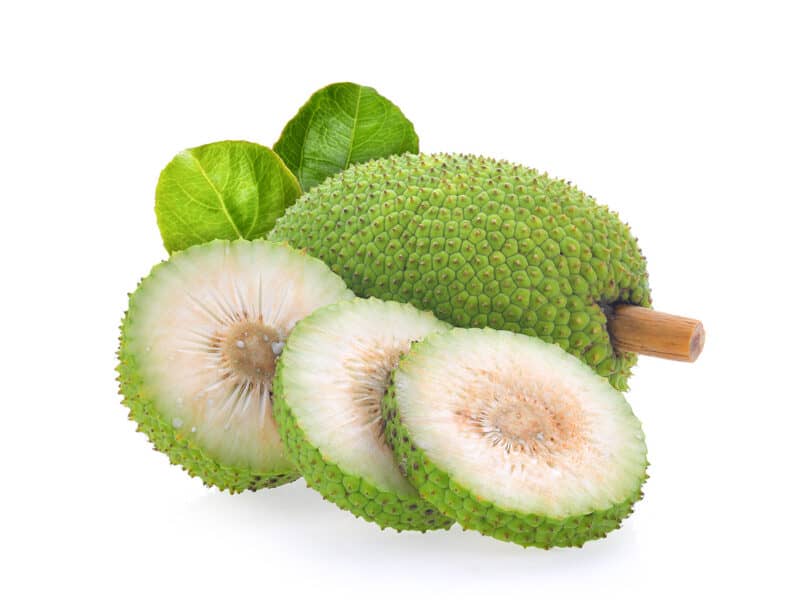
Some breadfruit turns a light shade of yellow when it’s ready. Others you can’t judge by the color.
It’s easier to tell by squeezing the fruit. If it’s soft and smells aromatic, it’s ready to be plucked. If it has fallen from the tree, it may be too late. It’s easily bruised.
Twist ripe breadfruit from its branch and then turn it upside down to bleed out the latex sap from the end.
Use the plant as a potato substitute. You can also candy breadfruit, roast it, mash it, or fry it up. Make “french” fries, and add to curries, stews, and many other dishes.
